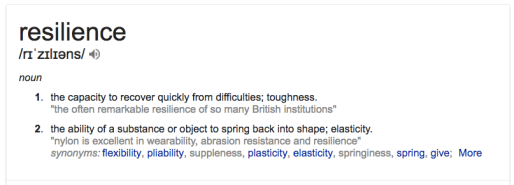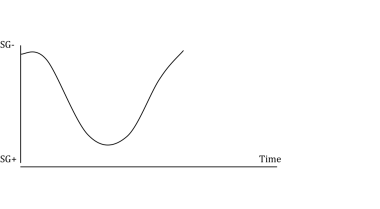I’ve been thinking a fair bit about this idea of resilience in learning and writing recently. This is partly because I have started a big project – a single-authored book – and I am really struggling to find my voice and the words, and the frustration is knocking me back a bit. This is also partly based on my ups and downs with peer review on papers I have written in the last two years, and how I have made sense of the process of peer review, even when it has hurt, so that I can keep moving forward. And I have been wondering how we develop resilience in academia, and as writers and thinkers, and whether and how we can help or teach students to develop this too.

Resilience is defined as the ability to bounce back from difficulties or setbacks, and to keep going without letting the setbacks overwhelm you; it is also defined as an elastic property of objects, that they can use to reform themselves into their proper shape when something has bent or pushed them out of shape. Resilience is a key element of success; you need to be able to get yourself up and keep going after a setback. For writers, setbacks often take the form of critical feedback that signals more work to do, more thinking, more writing. Sometime way more than we expected to have to do, or even want to do.
If you are an academic who has chosen a career that involves much writing and publishing, you accept that you will be knocked back but that you will have to keep moving. No journal article or book chapter is written in the first try – many drafts and revisions will need to be completed before it is ready to be read by your peers in a published form. But, for undergraduate students, this notion of writing and revising is not something familiar or even normal. Most assignments are written once, handed in, marked (sometimes with and sometimes without feedback or comments), and then moved on from. Few students have repeated opportunities to write a draft, have it read and commented on, and then make revisions to improve the paper.
The system of peer review, feedback, drafting and revision is not readily built into most undergraduate education, or even early postgraduate education, for example in a coursework or taught Masters programme. Perhaps this is why many students struggle to develop resilience against having their work or ideas critiqued, which should then prompt them to rethink, revise, and not feel defeated. A project I worked on several years ago built a first draft-revisions-final draft system into a course where students had previously had no opportunities to get feedback on an essay in progress. I thought most students would really like this system, but I found when I talked to them after the project that many had been frustrated and discouraged receiving feedback that meant they had more reading and writing to do, as they believed their essays were fine as they were. They didn’t want to make revisions; they wanted to give up and move on to something else.
I wondered, though, if this wasn’t a normal reaction from a first-year student encountering critical commentary on her work for the first time. Of course she would have that kind of reaction. Even experienced, published writers dread feedback as much as they appreciate the opportunities it affords them to improve their work. I further wondered if, given further drafting-feedback-revising opportunities in courses across the curriculum and thus made a normal part of undergraduate education, those students would have developed writer-resilience over time. Sure, the feedback may still have initially been upsetting or difficult to read, but with input from tutors and lecturers on how to use feedback to revise their work, these students may well have learned to get back up and keep writing, and would certainly have gained a great deal, both intellectually and emotionally, from that process.

I am aware that increasingly large classes, and linguistically and educationally diverse student bodies, make creating and sustaining writing intensive courses a challenge. But, some of this challenge stems less from the time it takes to read and comment on student work, and more from the nature of the curriculum being too full of things students need to learn and know and less with time for things students need to be able to do with what they know, such a problem-solving and argument-construction. I think this is an imbalance that may need to be corrected if we do take seriously helping our students to become more resilient thinkers and writers, an ability that will surely stand them in strong stead in further studies, and in the world of work.






